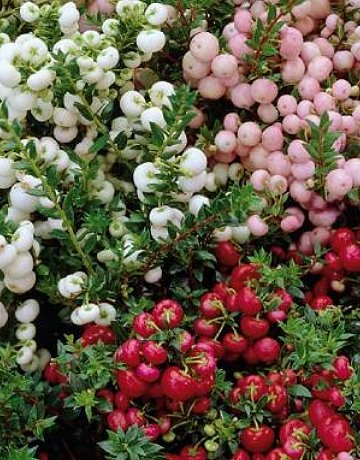
|
|
Prickly Heath
(Gaultheria mucronatai).
|
Prickly Heath - Gaultheria mucronata
Gaultheria is a genus of about 135 species of shrubs in the family Ericaceae. These plants are native to
Asia, Australasia and North and South America. In the past, the Southern Hemisphere species were often treated as the separate genus
Pernettya, but no consistent reliable morphological or genetic differences support recognition of two
genera, and they are now united in the single genus Gaultheria.
The genus Pernettya was designated by a French botanist, Charles
Gaudichaud-Beaupe, in 1825 to honor Antoine J. Pernetty, author of Bougianville's voyage to South
America. The genus Gaultheria was created earlier, in 1735, by C. Linnaeus to honor
Dr. Gaultier, a physician of Quebec City. Some 200 years later in a review of the two genera several hybrids of Gaultheria and Pernettya were
described, however, the authors did not suggest uniting the two genera, believing that more study was
needed. In 1990 a thorough study of the two genera was published and the authors concluded that Pernettya should not be maintained as a separate
genus. This has resulted in Pernettya being merged into Gaultheria, and the former intergeneric hybrids designated ÷-Gaultheria are now included in Gaultheria.
However, in the nursery trade the Pernettya designation is still frequently used.
The species vary from low, ground-hugging shrubs less than 10 cm (3.9 in) tall, up to 2.5 m (8 ft 2 in) tall, or, in the case of G. fragrantissima from the Himalaya, even a small tree up to 5–6 m (16–20 ft) tall. The leaves are evergreen, alternate (opposite in G. oppositifolia from New Zealand), simple, and vary between species from 3 to 10 cm (1.2 to 3.9 in) long; the margins are finely serrated or bristly in most species, but entire in some. The flowers are solitary or in racemes, bell-shaped, with a five-lobed (rarely four-lobed) corolla; flower colour ranges from white to pink to red. The fruit is a fleshy berry in many species, a dry capsule in some, with numerous small
seeds.
Gaultheria mucronata, known as prickly heath and in Chilean Spanish as chaura,
syn. Pernettya mucronata, is a species of flowering plant in the family
Ericaceae, native to southern Argentina and Chile. The Latin specific epithet mucronata means
“prickly”, referring to the foliage.
It is a compact, bushy, evergreen shrub with glossy green leaves and solitary white flowers in
spring, followed in autumn by showy globose berries up to 1.5 cm in
diameter. The
stiff, upright branches of Gaultheria mucronata are laden with these berries like gleaming china beads in colours from pearlywhite through pink to deep
claret. These start to form in July but are not in evidence until much later in the year and last through to the
spring.
When it blooms in May, it still has a good load of the previous year's
berries on all the branches. The previous year's berries in fact begin to grow larger after having remained small & shiny & fresh through the
winter. Iit is refreshing for a winter garden and find a shrub
that, even under January's austere regime, is every bit as showy
The plant is dioecious, meaning that both male and female plants must be grown together in order to produce
fruit. The plant is not self-fertile. It prefers moist, shaded conditions.
Fruit is edible raw or cooked. The lilac-coloured fruit does not look tremendously
edible, and the texture is somewhat like polystyrene - but the fruit of some forms is
juicy, almost melts in the mouth, has a very pleasant slightly sweet flavour and makes a very good dessert
fruit.
The plant can be used to make a low hedge. A good ground cover plant for a sunny
position, forming dense thickets. They are best spaced about 60cm apart each way. Plants can be cut back in the spring if they are becoming too lanky and open in
growth.
Source:
https://en.wikipedia.org/wiki/Gaultheria
https://en.wikipedia.org/wiki/Gaultheria_mucronata
https://pfaf.org/user/Plant.aspx?LatinName=Gaultheria+mucronata
https://landscapeplants.oregonstate.edu/plants/gaultheria-mucronata
